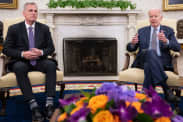The policy-sensitive 2-year Treasury yield finished at its highest in more than two months on Wednesday after minutes of the Federal Reserve’s May 2-3 meeting indicated some policy makers might be open to further interest rate hikes.
What happened
-
The yield on the 2-year Treasury
TMUBMUSD02Y,
4.564% rose 6.3 basis points to 4.343% after factoring in new-issue levels. Wednesday’s level is the highest since March 10, based on 3 p.m. Eastern time figures from Dow Jones Market Data. -
The yield on the 10-year Treasury
TMUBMUSD10Y,
3.756% advanced 2.1 basis points to 3.717% from 3.696% on Tuesday. -
The yield on the 30-year Treasury
TMUBMUSD30Y,
3.906% rose 1.3 basis points to 3.964% from 3.951% as of Tuesday. - The 10- and 30-year Treasury yields are each up eight of the past nine trading sessions.
What drove markets
Treasury yields finished higher on Wednesday after the release of minutes from the Federal Reserve’s May meeting. Participants on the rate-setting Federal Open Market Committee generally agreed that the extent to which additional rate hikes may be appropriate after this month had become less certain.
See: ‘Several’ Fed officials said more rate hikes may not be needed and other key takeaways from May minutes
Many participants “focused on the need to retain optionality after this meeting,” the minutes said. Even so, “some participants commented that, based on their expectations that progress in returning inflation to 2 percent could continue to be unacceptably slow, additional policy firming would likely be warranted at future meetings.”
Yields began moving higher earlier in the session, when Fed Gov. Christopher Waller said he would back more rate hikes unless there’s more progress on inflation. Fed funds futures traders put the chance of another quarter-of-a-percentage-point rate hike on June 14, at 29% which would take the Fed’s main interest-rate target to between 5.25%-5.5%, according to the CME FedWatch tool. Traders also see an 11% chance of another quarter-point hike in July.
Meanwhile, yields on 1-month through 1-year Treasury bills were all above 5% and either at or near multiyear highs on Wednesday as concerns about the debt-ceiling deadline next week continued to pressure the market for government debt. The rate on the 1-month Treasury bill, one of the maturities trading as a proxy for debt-ceiling angst, was at 5.768% as of 3 p.m. Eastern time, according to Tradeweb. That’s above its multi-year closing level of 5.68% reached on May 12.
Read: Debt-ceiling angst drives more Treasury bill yields above 6%
On Wednesday, U.S. Treasury Secretary Janet Yellen expressed concern about “substantial financial-market distress,” even if there is a debt-ceiling deal. Meanwhile, House Speaker Kevin McCarthy told reporters that he was hopeful for progress in negotiations and “firmly” believes an agreement will be reached.
U.K. government bonds were the notable underperformers on Wednesday, with 2-year yields
TMBMKGB-02Y,
What analysts are saying
Referring to the Fed’s May meeting minutes, BMO Capital Markets strategist Ben Jeffery said: “As for what it all means for the path of policy from here, any further tightening will need to be predicated on the data, and the Committee is pursuing optionality both as it pertains to June’s hike or pause, but also beyond. This puts the onus on next week’s employment report, along with the June 13 release of CPI to determine whether or not the FOMC will opt to deliver another 25 bp hike this cycle.”







